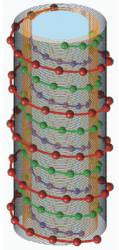As if searching for life wasn’t already difficult enough, physicists now think that clouds of particles in space could mimic the behaviour of life: dividing, replicating and even evolving. This discovery could help scientists understand how life got started here on Earth, and offers intriguing possibilities for life that could evolve in the interstellar clouds of outer space.
This discovery comes from European and Australian researchers, and their work is published in today’s issue of the New Journal of Physics. They developed computer simulations that showed how clouds of molecules naturally organize themselves into complex helix-like structures that resemble DNA.
Over time, an electrical process called polarization organizes the molecules into more and more complex structures. According to the researchers, this suggests a mechanism where organic molecules could assemble faster than in previous models. This shorter time frame means that complex life could be prevalent across the Universe – they get part of the way in space, and then finish off when they reach a planet. Astronomers have already observed vast clouds of these particles out in space with radio telescopes.
Life on Earth requires water, and these molecules wouldn’t have access to the liquid in the near absolute zero temperatures of interstellar space; however, they are able to interact through this polarization process. So there might be a limit, where the structures can’t become complex enough to seed life on young planets. But this process could begin the formation of life, from a random collection of atoms to more complex molecules, and eventually the precursors of life. Evolution could then take over.
Original Source: Science Now


My friend on Facebook shared this link with me and I’m not dissapointed that I came here.